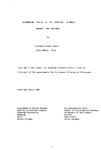GEOCHEMICAL CYCLES OF THE ATMOPHILE ELEMENTS ARSENIC AND ANTIMONY
| dc.contributor.author | Austin, Laurence Stuart | |
| dc.contributor.other | School of Biological and Marine Sciences | en_US |
| dc.date.accessioned | 2013-11-01T10:50:03Z | |
| dc.date.available | 2013-11-01T10:50:03Z | |
| dc.date.issued | 1984 | |
| dc.identifier | NOT AVAILABLE | en_US |
| dc.identifier.uri | http://hdl.handle.net/10026.1/2514 | |
| dc.description.abstract |
Atmospheric aerosol samples from coastal and open ocean environments in the North Atlantic were analysed for the atmophile elements arsenic and antimony, and for the marine tracers sodium and magnesium. The aerosol concentrations of sodium and magnesium were similar in both environments, about 2000 ng Na (SCM)ˉ¹ and 320 ng Mg (SCM)ˉ¹. The atmophiles were more concentrated in the coastal aerosol, 0.67 ng As(SCM)ˉ¹ and 0.32 ng Sb (SCM)ˉ¹, than in the open ocean aerosol, 0.07 ng As (SCM)ˉ¹ and 0.086 ng Sb (SCM)ˉ¹, and as continental particles were only observed in the coastal aerosol, this indicates that arsenic and antimony in the marine aerosol are of continental origin. Total deposition fluxes to the North Atlantic were about 1.4 kt yrˉ¹for arsenic and antimony, and about 12 t As yrˉ¹ and 5 t Sb yrˉ¹to the dissolved phase of the English Channel. Coastal deposition was higher than the dissolved element fluxes from the River Tamar. From the above data, steady state models of the arsenic cycle were developed, and an anthropogenic perturbation rate was calibrated for kinetic analysis, to define the most sensitive areas of the geochemical cycle. Air-sea exchange exerts a major control on the atmospheric transport of pollutant arsenic to the sea, variations in river flow exert a minor influence. The major unknown factor in the biogeochemistry of arsenic is the size of the reservoir for low temperature anthropogenic mobilisation, as this has a larger long term effect than industrial pollutant input. Low temperature mobilisation may lead to a serious increase in the atmospheric arsenic burden. The modelling technique was extended to quantify a novel tentative model for antimony, which was subject to limited examination by kinetic analysis. Again, air-sea exchange exerts a major influence on the atmospheric transport of pollutant antimony to the oceans, although river flow exerts a larger influence than for arsenic. Low temperature mobilisation may be even more significant for antimony than for arsenic. | en_US |
| dc.description.sponsorship | School of Environmental Sciences, University of East Anglia, Norwich, East Anglia | en_US |
| dc.language.iso | en | en_US |
| dc.publisher | University of Plymouth | en_US |
| dc.title | GEOCHEMICAL CYCLES OF THE ATMOPHILE ELEMENTS ARSENIC AND ANTIMONY | en_US |
| dc.type | Thesis | |
| plymouth.version | Full version: final and full version as approved by the examiners at the time of the award of your degree | en_US |
| dc.identifier.doi | http://dx.doi.org/10.24382/3259 | |
| dc.identifier.doi | http://dx.doi.org/10.24382/3259 |
Files in this item
This item appears in the following Collection(s)
-
01 Research Theses Main Collection
Research Theses Main


